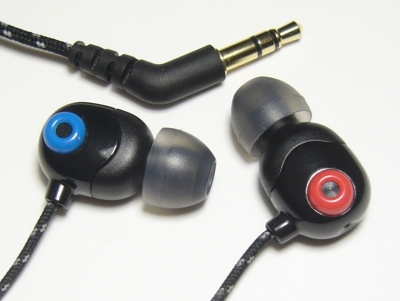Details: Fischer Audio’s vertical dual dynamic in-ear
MSRP: approx. $129 (manufacturer’s page)
Current Price: $75 from fischer-products.eu
Specs: Driver: Dual Dynamic | Imp: 36Ω | Sens: 105 dB | Freq: 20-20k Hz | Cable: 4.1’ 45º-plug
Nozzle Size: 5mm | Preferred tips: stock wide-channel single-flanges
Wear Style: Straight down or over-the-ear
Accessories (3/5) – Narrow-tube (4 sizes) and wide-tube (3 sizes) single-flange silicone tips, bi-flange and tri-flange silicone tips, soft drawstring carrying pouch
Build Quality (3.5/5) – The housings of the Tandem are made entirely of matte and glossy plastics, with red and blue trim taking the place of L/R markings. Metal nozzle filters and somewhat tangle-prone nylon-sheathed cables are shared with a few of Fischer’s other models. The lack of strain relief on housings entry is worrisome but not a deal breaker
Isolation (3/5) – The Tandem is vented at the rear and can’t be inserted too deeply due to the large housings. Isolation is moderate even with longer eartips
Microphonics (3.5/5) – Reasonable despite the nylon-sheathed cord and lack of shirt clip; good when worn cable-up
Comfort (3/5) – The drivers of the Tandem are oriented parallel to the nozzle, one above the other, resulting in a housing that is elongated vertically. Ergonomics are good considering the size and it can be worn over-the-ear easily but tends to be sensitive to insertion depth and may cause long-term comfort issues for those with smaller ears
Sound (8.6/10) – The sound of the Tandem is extremely smooth and liquid, reminding me in many ways of the Sunrise Xcape IE. The bass has plenty of punch and carries realistic weight. It’s not as deep and powerful as with the Radius dual dynamics but the reach is good and there is a bit more impact compared to the Xcapes. While the overall note presentation is a touch soft and the Tandem doesn’t seem to have the ability to become hard and aggressive the way crisper-sounding IEMs like the HiSound Crystal can, the absence of distracting mid-bass bloat keeps the low end clean and controlled. The Tandem may be a bit slower than the VSonic GR07 and HiSound Crystal but it is quick and resolving enough to make Sennheiser’s IE6 and IE7 – as well as Beyerdynamic’s DTX 101 iE – sound loose and flabby in comparison.
The midrange is lush and very smooth, sharing the liquid and slightly warm character of the Xcape IE. It is not too clear from the specifications but as far as I can tell no crossover is used by the Tandem, meaning that both drivers cover the entire frequency spectrum, and the overall smoothness of the sound may be a testament to that. Balance is good compared to the Radius DDM2, with the Tandem’s mids being more prominent and never becoming overshadowed by the low end. The DDM2 does have an edge in clarity and tends to sound more airy and open but the clarity of the Tandem is still very reasonable. The detail level, too, while not quite a match for Fischer’s own similarly-priced BA-based SBA-03, is good for a mid-range dynamic. Like the Xcape IE, the Tandem really isn’t for those who prefer an analytical edge.
The treble of the Tandem, while not noticeably lacking, is not particularly prominent or energetic. As with the midrange, the overall smoothness is excellent, with no hint of grain or harshness. Extension is not bad but the treble becomes increasingly laid-back towards the top of the spectrum. I won’t say that the Tandem sounds dark but the treble quantity lags slightly behind that of the DDM2 and misses out completely on the upper midrange lift present in so many clarity-focused earphones. As a result, the sound of the Tandem is extremely non-fatiguing and very forgiving – so much so that it makes even the Sennheiser IE7 sound edgy and unpleasant.
The presentation, too, is spacious but not overly enveloping. The soundstage has better width and depth than that of the Sunrise Xcape IE but lags slightly in overall size behind the DDM2. Layering is good and instruments are reasonably well-separated. Despite leaning towards a softer note presentation overall, the Tandem has above-average dynamics and experiences no problems portraying distance or intimacy. Worth noting is one side effect of using dual dynamic drivers – the Tandem is not the most efficient earphone out there and will require a few extra volume notches than many competing earphones to reach listening volume. Sensitivity isn’t an issue, however, and the Tandem will still satisfy at moderate volumes.
Value (7.5/10) – The Fischer Audio Tandem may be the most versatile dual dynamic I’ve used so far but it still lags behind modern single-driver designs slightly in user-friendliness. The large, toy-like housings do not sit well enough in smaller ears and the included assortment of eartips, while certainly good considering the sensitivity of the Tandem to insertion depth, doesn’t quite make up for the lack of other pack-ins. In terms of sound quality, however, there isn’t much to complain about with the Tandem – its signature is not one that impresses immediately but it is very likable and easy to appreciate, especially over long listening sessions. It really is a case of the end result being superior to the sum of its parts and an easy earphone to recommend for those who value balance and smoothness over analytical clarity or monstrous bass.
Pros: Extremely smooth & forgiving sound
Cons: Large housings, mediocre accessory pack



